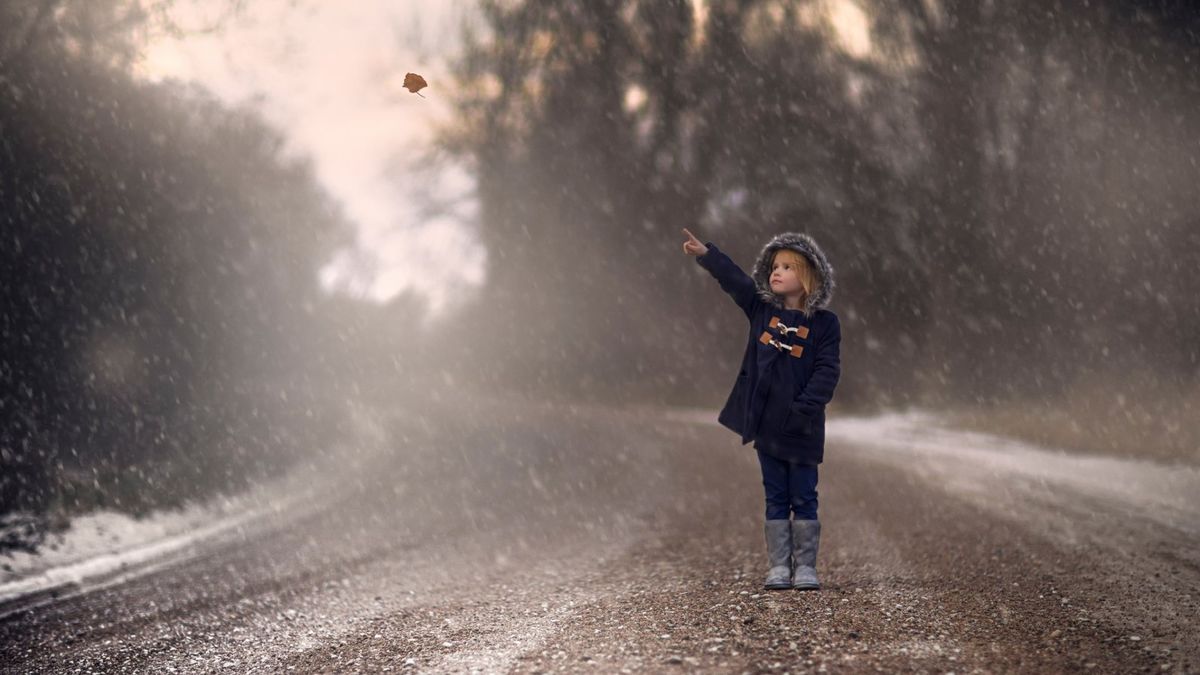The Child and the Falling Leaf

The photograph presents a poignant scene: a young child, bundled in winter attire, stands on a snow-dusted road, their small finger pointing upwards, following the trajectory of a single, browning leaf caught in a gentle snowfall. The image is more than just a pretty picture; it’s a microcosm of philosophical themes surrounding time, change, wonder, and the human experience of the natural world.
The most striking element is the contrast between the child's focused attention and the vast, indeterminate background. The blurred trees and falling snow create a sense of depth and mystery, suggesting the immensity of the universe and the fleeting nature of individual experiences. The child, small and seemingly insignificant against this backdrop, becomes a symbol of humanity's place within the grand scheme of existence. We are but fleeting moments within the continuous flow of time, much like the leaf that falls from the tree.
The falling leaf itself is a potent symbol of impermanence. Its journey from branch to ground is a visual metaphor for the cyclical nature of life, death, and rebirth. The leaf's brown hue signifies the transition from vibrant life to decay, a process that mirrors human mortality. Yet, there is a beauty in this decay, a quiet dignity in the leaf's acceptance of its fate. The child, by observing the leaf, engages with this natural process, acknowledging the inevitability of change. This observation is not passive; it is an active engagement with the world, a recognition of the transient nature of all things.
The child's pointing finger is significant. It’s not a gesture of control or dominance, but rather one of wonder and curiosity. The child is not trying to stop the leaf’s fall; rather, they are tracing its path, observing its journey with a sense of innocent fascination. This act highlights the childlike capacity for awe and wonder, a quality often lost in adulthood's preoccupation with control and predictability. The child's attention is focused on a single, seemingly insignificant event, yet this event holds profound meaning. It is a reminder that moments of profound beauty and significance can be found in the everyday, the mundane.
The snow adds another layer of complexity. It’s a symbol of both transience and purity. The snowflakes, like the leaf, are temporary, melting away as quickly as they appear. Yet, their ephemeral existence adds to the overall beauty of the scene. The snow also suggests a sense of quietude and stillness, creating a contemplative atmosphere that encourages reflection. The child's presence within this snowy landscape emphasizes their vulnerability and connection to nature. They are not separate from the environment; they are a part of it, subject to its rhythms and cycles.
The photograph's muted color palette enhances its contemplative mood. The subdued tones of brown, gray, and blue create a sense of serenity and introspection. The lack of vibrant colors directs the viewer's attention towards the subtle details of the scene, encouraging a deeper engagement with the philosophical implications of the image.
In conclusion, the photograph transcends its visual appeal to become a meditation on the ephemeral nature of existence. The child's focused gaze on the falling leaf serves as a reminder of the importance of appreciating the present moment, of finding wonder in the seemingly insignificant, and of accepting the cyclical nature of life and death. It is a quiet testament to the enduring power of observation and the inherent beauty of impermanence. The child, in their innocent act of observation, becomes a symbol of our shared human experience – a journey through time, marked by moments of fleeting beauty and profound contemplation.
Like 1 Pin it 0


